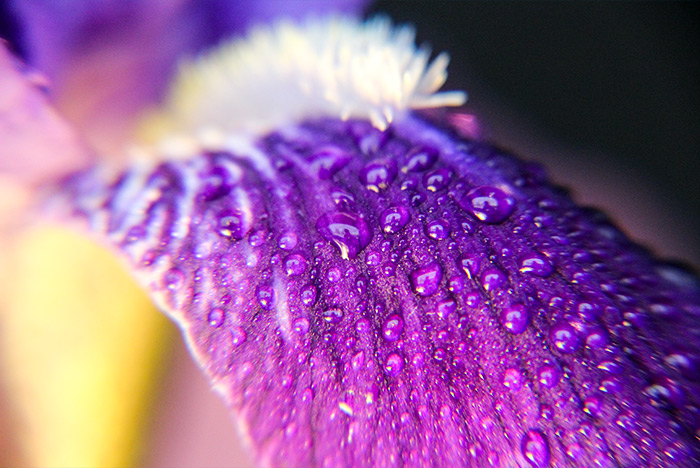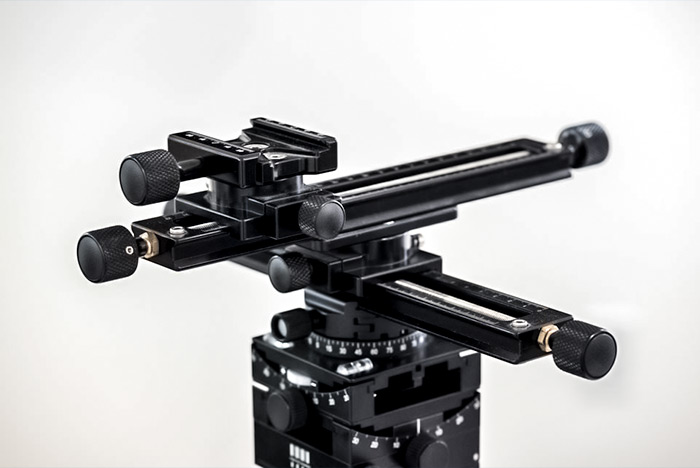Part of taking great photography comes from knowing which gear to use for a given situation. While it’s easy and fun to grab a camera with an 18-55mm kit lens and run outside to take some photos of an owl perched on a branch, you won’t be getting any very good shots of it unless you figure out a way to get quite close to it without it flying away. In the same vein, when attempting to take very close up photos of the insides of a flower or of an insect, you most likely won’t have the ability to keep your hands as steady as is necessary to avoid camera shake or to maintain the proper depth of field. Remember, the closer you get to a subject, the more shallow the depth of field becomes, even at medium to small aperture sizes.
Use a Focus Rail For Better Macro Photography
For both of these situations, specialized camera gear is called for. In the first example, a telephoto lens that could easily reach up to the owl would help out exponentially. That way, you wouldn’t have to risk having the bird fly away as you climb the tree in an attempt to get closer to it. In the second example, a tripod is absolutely necessary. That would keep your camera steady while you concern yourself with other settings on the camera and focusing in on the part of the flower you might want to capture. But in this instance, there’s another piece of gear that wold most likely come in handy and that’s what I’d like to discuss down below.
By the way, much of the inventory of what’s sold in today’s camera stores and online isn’t readily known to beginner and amateur photographers. These types of photographers oftentimes stumble through their formative years until they discover the piece or pieces of equipment that may have helped them so much along the way. For example, imagine yourself trying to take some macro photography on a nice sunny day while hand holding your camera. After taking many shots, it’s likely that you’d review them later on at home to realize that many of the shots are blurry or that the depth of field surrounded the wrong part of whatever it was that you shot earlier. If you had a tripod and the little nugget of wonder that I’m going to share below, you’d likely be confident with your results because you’d focus much of your efforts on other things while taking the shots, such as previewing the shot, working aperture size and focus. Holding the camera steady should be the last thing on your mind.

Introducing the Focus Rail
Back when I first began getting into photography, I tried my hand at taking some macro shots. I wasn’t bad because I knew to take advantage of a tripod. What I noticed though was that as I was setting the photos up, I’d have to move the tripod slightly in any and every direction to have the focus targeted on the area I wanted it targeted on. And when I say “slightly,” I mean centimeters. The setup didn’t call for me moving the tripod much at all, but when I did try to nudge it one way or another, I’d generally overshoot, which was frustrating to say the least. Believe me when I say this, I wish I knew of a better way to move the camera slightly from side to side and back and forth.
If memory serves, I believe I relied heavily on zooming the lens in and out in an effort to maneuver the focus where I wanted it. This wasn’t ideal though because as I zoomed, the depth of field would become more shallow. I didn’t want that, so again, I became frustrated. Another side effect of my zooming was that the subject would become larger in the frame. I didn’t want that either.
At least I knew enough to use a tripod, so my images came out better than I expected them to. As a matter of fact, the image above is one of them. I captured that years ago. I placed the flower in the trunk of my car and illuminated it with a drop light. You would laugh if you saw my garage “studio.”
I would much rather have had a device that would simply move the camera for me in slight increments, as opposed to me having to zoom or nudge the tripod with my foot. As it just so happens, there actually is a device and it’s called a Focus Rail. Here, take a look at it.

There are a wide variety of these types of devices, but I chose this one because it’s a solid representation of what one looks like and what it’s capable of.
How Can a Focus Rail Help With Macro Photography?
If you take a look at the image of the focus rail above, you’ll notice small dials that are attached to the rails themselves. Some of those dials clamp down and hold the camera in place while other dials move the camera along the rails in increments. Basically, the way it works is like this; you attach the focus rail to your tripod and then your camera to the focus rail. Then, you set your shot up as best you can and when you’re ready to fine tune things, you rely on the focus rail’s minute movement capabilities to do that. With rails like this, you’re given the ability to adjust your camera by fractions of an inch at a time. With one of these devices, after initial setup, there’s no more need to gently nudge your tripod with your foot, like I did back in the day. And you won’t need to zoom in and out anymore like I used to do as well.
With most focus rails, you’ll have the ability to move the camera to the left and right and forward and backward tiny distances. So since your depth of field will most likely be very shallow with your macro photography, you’ll have an easy time of creeping up on that perfect focal spot by simply twisting a dial or two. If you need larger movements, you can always slide the camera along the rails in one or two fell swoops. That process is just as simple.
Do you remember that post I wrote on focus stacking? Well, just as luck would have it, focus rails are a focus stacker’s best friend. Imagine yourself in the middle of a macro photo shoot and finding that your shot’s depth of field is just too shallow. This actually happens a lot. If you use your camera to take a first shot and then move your camera forward by using the focus rail and then take another shot and then follow that process for multiple shots, you’ll have the ability to quite easily merge those images together inside of Adobe Photoshop by using the focus stacking utility. Now that’s something to write home about and this process will give you a much deeper depth of field.
Remember though, the focus rail is good for non-moving subjects. If the subject is moving, you’ve got an entirely new set of issues to deal with.
I hope I clearly introduced a new piece of camera gear to you as well as explained a bit about what it’s good for and how a focus rail works. If you have any questions regarding this section, please ask down below. Thanks for reading!
Focus Rails + Focus Stacking
According to what I shared above, the conclusion I came to was that using a focus rail that’s attached to a tripod and having your camera mounted on the focus rail is the best way to go as far as making small positioning adjustments for macro photography. There are tons of brands that make focus rails, so do your research. Surprisingly, these little devices cost quite a bit, being around $300 to $400 and even more, I’m sure.
Basically, you can’t hand hold your camera while shooting up close for macro photography. You’ll end up getting blur from camera shake and you’ll also be concentrating on all the wrong things while taking the photo. You definitely need a tripod and for all those minor movements and adjustments, you’ll need a focus rail. The reason for this is the extremely shallow depth of field that comes with being so close to an object. I’m talking millimeters here. The focus rail offers the slightest adjustments so that depth of field covers just the right spot of your subject.
To me, the more valuable benefit of using a focus rail is having the ability to take multiple shots with slightly different focal points. If you take one shot with the depth of field targeted toward the closest part of the object and then continue on working your back with more photos, you’ll end up with quite a few photos with different focal planes. Once you import those photos into Adobe Photoshop, you can focus stack the images for a much deeper depth of field. This can be huge when it comes to macro photography. Quite the effect.
What are your feelings on focus rails in conjunction with focus stacking? Have you tried this technique? If so, please chime in down below. Also, if you have any questions, don’t hesitate to ask down below too. Thanks!

Leave a Reply